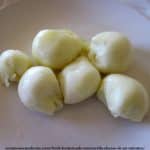Fresh Homemade Mozzarella Cheese Recipe – Make Mozzarella Balls!
Quick and easy homemade mozzarella cheese recipe, ready in about 30 minutes, that you can use to make homemade mozzarella cheese balls or string cheese.
Ingredients
1 1/2 level teaspoons citric acid dissolved in 1/2 cup cool water
1 gallon pasteurized whole milk
1/4 teaspoon liquid rennet (or 1/4 rennet tablet) diluted in 1/4 cup cool, unchlorinated water
1 teaspoon cheese salt (optional)
Instructions
1. Prepare the Ingredients
Begin your cheese making process by prepping the ingredients listed above. Dissolve 1 1/2 teaspoons citric acid in 1/2 cup cool water. Place your milk in a large stock pot. Mix your rennet with 1/4 cup cool water.
2. Heat the Milk and Add the Citric Acid
Gently bring the milk up to 55°F ( 13°C) in a large, stainless steel pot. While stirring, add the citric acid solution to the milk and mix thoroughly.
3. Add the Rennet
Heat the milk to 90°F (32° C) over medium-low heat, stirring constantly. Remove the pot from the heat and gently stir in the diluted rennet with an up-and-down motion for 30 seconds. (We use a potato masher to move the milk up and down.) Cover the pot and leave undisturbed for five minutes.
4. Cut the Curd
Check the curd. It should look like custard, with a clear separation between the curd and whey. (If the curd is too soft or the whey is too milky, let set for a few more minutes.) Cut the curd with a knife that reaches all the way to the bottom of your pot.
5. Heat the Curds
Place the pot back on the stove and heat the curds to 105°F (40°C), gently moving the curds around with your spoon. Remove from heat and continue to stir slowly for 2 to 5 minutes. (Stirring for 5 minutes will result in firmer cheese.)
6. Drain the Curd
Scoop out the curds with a slotted spoon and put into a 2 quart microwaveable bowl. Press the curds gently with your hands, pouring off as much whey as possible.
***If you do not have a microwave:
After step 6, heat the reserved whey on the stove top to at least 175°F (80°C). Add 1/4 cup of cheese salt to the whey (you could probably substitute kosher salt, but cheese salt is best). Shape the curd into one or more balls, put them in a ladle or strainer, and dip them into the hot whey for several seconds. Knead the curd with spoons or gloved hands between each dip and repeat this process several times until the curd is smooth and pliable. Please be careful! This is really hot, and working with more liquid increase the risk of getting splashed!
7. Heat the Curds and Stretch the Mozzarella Cheese
Microwave the curds on high for 1 minute. Drain off all excess whey. Gently fold the cheese over an over (as in kneading bread) with your hands or a spoon. This distributes the heat evenly throughout the cheese, which will not stretch until it is too hit to touch (145°F (63°C) inside the curd). Rubber kitchen gloves are very handy at this stage.
8. Stretch and Salt Your Mozzarella
Microwave two more times for 35 seconds each; add salt to taste after the second time. After each heating, knead again to distribute the heat.
9. Knead the Mozzarella until Smooth and Elastic
Knead quickly until it is smooth and elastic. When the cheese stretches like taffy, it’s done. (See top photo in post.) If the curds break instead of stretch, they are too cool and need to be reheated.
10. Shape the Mozzarella
When the cheese is smooth and shiny, roll it into small balls and eat while warm. Or place them in a bowl of ice water for half an hour to bring the inside temperature down rapidly; this will produce a consistent smooth texture throughout the cheese. Although best eaten fresh, it can be stored in the refrigerator at this point.
With some experimentation, I found you can pull this mozzarella cheese into strips or strings – think “homemade string cheese”. Pull the strips, drop them in the water to cool, then pack them tightly in a Pyrex container or wrap in plastic wrap. They’re not as pretty as the store bought ones, but they work just the same.
Although the original recipe recommended storing the cheese in water, I prefer storing it in a tightly sealed container without water. Water storage makes the cheese soft and washes out the salt.
Notes
Optional Lipase Powder
If you want to add lipase powder to give the cheese more flavor, use 1/8 – 1/4 teaspoon, dissolved in 1/4 cup cool water and allowed to sit for 20 minutes. To start, probably try the mild and see how you like the flavor. Add the lipase and water mixture at the same time you add the citric acid solution. If you add lipase to this cheese, you may have to use a bit more rennet, as lipase makes the cheese softer.
